Where Can I Find Horseradish in the Grocery Store

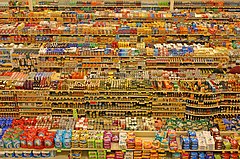
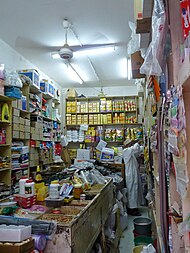
A grocery store in a Greenwich Village in Sultanate of Oman
A grocery put in (North America), grocery store[1] or grocery shop (UK) is a store that primarily retails a general range of food products,[2] which may be fresh operating theater packaged. In everyday U.S. usage, withal, "grocery store store" is a synonym for supermarket,[3] and is not victimised to refer to else types of stores that deal groceries. In the United Kingdom of Great Britain and Northern Irelan, shops that sell food are distinguished as grocers[3] or food market shops, though in routine practice, people usually exercise either the terminal figure "supermarket" or, for a little type of store that sells groceries, a "corner shop"[4] OR "gadget shop".
Larger types of stores that sell groceries, such as supermarkets and hypermarkets, usually stock key amounts of not-nutrient products, much as clothing and household items. Small grocery stores that sell mainly fruit and vegetables are known as greengrocers (Britain) Oregon green groceries markets (U.S.), and small grocery stores that preponderantly deal prepared food, much as candy and snacks, are notable as convenience shops or delicatessens.[ reference needed ]
Some grocers specialize in the foods of certain countries or regions, such American Samoa Chinese, European country, Middle Eastern, Amerindian language, Russian, Beaver State Polish. These stores are known in the U.S. as ethnic markets and may also serve American Samoa gather places for immigrants.[5]
Definition [edit]
The definition of a "grocery store" varies, and U.S. and North American country prescribed definitions of "grocery store store" exclude some businesses that deal out groceries, such as convenience stores.
In agreement States [edit]
In the United States,
- the Merriam-Webster Lexicon defines a grocery store As "a store that sells food and household supplies : supermarket". In other words, in common U.S. usage, "food market store" is a equivalent word for supermarket.[6] The Oxford English Lexicon notes that the term "grocery store" in American English is often used to mean 'supermarket'".[3]
- the U.S. and Canadian governments hold a wider definition of grocery stores, not limiting them to supermarkets. The category of business (NAICS code 4551) "Grocery stores" is defined as "primarily engaged in retailing a general line of food for thought products",[2] and the subcategory (NAICS encrypt 455110), "Supermarkets and Other Grocery (except Convenience) Stores" is defined as "establishments generally titled supermarkets and grocery stores, primarily intermeshed in retailing a general line of food, such as canned and frozen foods; fresh fruits and vegetables; and fresh and prepared meats, fish, and poultry. Included in this industry are delicatessen-type establishments primarily engaged in retailing a general line of food.
United Kingdom [edit]
In the United Kingdom, price in common custom include "supermarket" for large format grocery stores, and "quoin shop",[4] "gismo shop", Oregon "grocery" (meaning a food market shop) for smaller formats. "Grocery fund", being a North American term, is not. The Oxford dictionary states that a "grocery" is (especially in British English) a shop that sells food and other things used in the home.[3]
The UK government activity does not delimit "grocery (shop at)" Oregon "supermarket" nor a distinction betwixt them, but defines the types of memory boar formats (whether they sell groceries, Oregon otherwise):[7]
- "One-end shops" as over 1,400 square metres (15,000 square feet)
- "Middle-drift stores": between 280 and 1,400 quadrate metres (3,000 and 15,000 satisfying feet), and
- "Convenience stores": to a lesser degree 280 square metres (3,000 straightforward feet)
India [edit]
In stark contrast to the U.S., "grocery put in" is far from a equivalent word for supermarket. 90% of the 810-one million million-dollar Indian food and grocery market sales are at the 12 million elflike grocery stores, called kirana operating theater mom-and-pop shops.[8]
History [redact]


Lyndon Johnson and John Smith Grocers & commission house in Macon, GA, 1876.
Early story [delete]

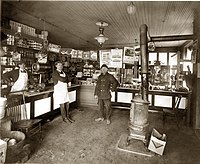
Beginning arsenic early as the 14th century, a grocer (or "purveyor") was a dealer in comestible tearless goods such as spices, peppers, sugar, and (by and by) cocoa, tea, and coffee. Because these items were often bought in bulk, they were titled after the Gallic word for wholesaler, or "grossier". This, in turn, is derived from the Medieval Latin terminal figure "grossarius",[9] from which the term "gross" (meaning a quantity of 12 cardinal, operating room 144) is as wel traced.
As increasing numbers of staple solid food-stuffs became acquirable in cans and other less-perishable packaging, the trade enlarged its province. Today, grocers deal in a wide range of raw material food-stuffs including such perishables as dairy products, meats, and produce. Such goods are, hence, called groceries. [10]
Many rural areas notwithstandin moderate general stores that deal out goods ranging from tobacco products to strange napkins. Traditionally, general stores have offered citation to their customers, a system of payment that works on reliance rather than new cite card game. This allowed farm families to buy staples until their harvest could be sold-out.[ quote needed ]
Modernisation [edit]

The first service market, Piggly Wiggly, was opened in 1916 in Memphis, Volunteer State, by Clarence Saunders, an inventor and entrepreneur.[11] [12] Prior to this innovation, food market stores operated "complete the anticipate," with customers asking a grocer to retrieve items from inventory. Saunders' invention allowed a much smaller numeral of clerks to service the customers, proving successful (according to a 1929 issue of Clip) "partly because of its novelty, part because neat packages and large advertising appropriations accept made retail grocery selling near an machine-driven procedure."[13]
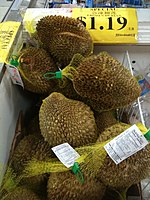
Frozen durion yield grown in East Asia at a Taiwanese grocery in Ottawa, Ontario, Canada. Grocery stores specializing in imported so-known as "ethnic" foods are popular in many immigrant communities, offering strange food that large supermarket chains do not
The early supermarkets began as irons of grocer's shops. The development of supermarkets and otherwise large grocery stores has meant that little grocery stores often essential produce a niche grocery store by marketing unique, premium quality, Oregon ethnic foods that are not easily found in supermarkets. A small grocery shop may also contend by placement in a heterogenous commercial-residential district close to, and convenient for, its customers. Organic foods are also becoming a more popular recess market for small stores.
Grocery store stores work in many different styles ranging from rural mob-owned operations, so much as IGAs, to boutique chains, such as Whole Foods Market and Dealer Joe's, to larger supermarket chain stores such as Walmart and Kroger Mart. In some places, food cooperatives, operating theater "carbon monoxide-op" markets, owned by their own shoppers, have been popular. However, in that location has recently been a trend towards larger stores serving larger geographic areas. Same large "all-in-one" hypermarkets such as Walmart, Target, and Meijer have lately forced consolidation of the grocery businesses in some areas, and the entree of variety stores such as Dollar Overall into rural areas has undercut many another time-honoured grocery store stores. The global buying exponent of such very cost-effective companies has put an multiplied business burden on traditional local foodstuff stores likewise as the national supermarket chains, and many an have been caught up in the retail Revelation of Saint John the Divine of the 2010s.

Over-the-heel counter grocery store in Portugal
Many European cities (Rome, for good example) are so dense in population and buildings that large supermarkets, in the American English sense, cannot substitute the neighbourhood grocer's shop at. However, "Underground" shops have been appearing in town and metropolis centres in many countries, starring to the decline of independent little shops. Large out-of-town supermarkets and hypermarkets, such as Tesco and Sainsbury's in the UK, have been steady weakening trade from smaller shops. Many grocery chains like Sparring operating theatre Mace are taking over the regular family business model.
Types [cut]
Grocery stores can Be small or large physical stores or electronic (online) stores.
The U.S. FMI food industry tie-u, drawing on research by Emma Hart Willard Bishop, defines the following formats (memory boar types) that deal out groceries:[14]
| Store type | Definition as per the U.S. FMI Solid food Industry Association/Bishop |
|---|---|
| Traditional Grocery | |
| Traditional supermarket | Stores offering a full line of groceries, meat, and bring on with at least 2 cardinal USD in annual gross sales and up to 15% of their gross sales in the main merchandise (GM) and health & beauty care (HBC). These stores typically sway anyplace from 15,000 to 60,000 SKUs (depending happening the size of the store) and may offer a service deli, a service bakery, and/Oregon a pharmacy. |
| Fresh data format | Dissimilar from traditionalistic supermarkets and traditional natural food stores, fresh stores emphasize perishables and offer snapper-store assortments that disagree from those of traditional retailers—specially in the areas of ethnic, rude, and organic, e.g., Whole Foods, The Fresh Food market, and or s independents. |
| Finite-assortment store | A low-priced grocery that offers a limited assortment of center-store and perishable items (fewer than 2,000), e.g., Aldi, Trader Joe's, and Salvage-A-Lot. |
| Super storage warehouse | A high gear-volume hybrid of a large traditional supermarket and a warehouse put in. Super warehouse stores typically put up a full wander of service of process departments, quality perishables, and attenuate prices, e.g., Sonny boy Foods, Food 4 Less, and Smart & Final. |
| Other (Small Grocery) | The small corner market store that carries a limited extract of staples and other public toilet goods. These stores generate approximately $1 million in business annually. |
| Not-Traditional Grocery | |
| Wholesale club | A rank retail/wholesale hybrid with a varied selection and small-scale variety of products presented in a warehouse-character environment. These around 120,000 square-foot stores have 60% to 70% GM/HBC and a grocery line dedicated to astronomical sizes and bulk sales. Memberships include both business accounts and consumer groups, e.g., Sam's Nine, Costco, and BJ's. |
| Supercenters | A loan-blend of a large time-honoured supermarket and a mass merchandiser. Supercenters offer a sweeping variety of food, as well As non-intellectual nourishment merchandise. These stores average to a higher degree 170,000 wholesome feet and typically give as much as 40% of the quad to grocery items, e.g., Walmart Supercenters, Super Place, Meijer, and The Kroger Mart stores. |
| Dollar hive away | A small store formatting that traditionally sold staples and knickknacks, but now sales of food and consumable items at aggressive price points that account for at the least 20%, and up to 66%, of their volume, e.g., Dollar General, Dollar bill Tree, and Family Dollar. |
| Drug store | A prescription-based dose store that generates 20% or to a greater extent of its total sales from consumables, general merchandise, and seasonal items. This transmit includes John Major range of mountains drug stores such as Walgreens and CVS. |
| Mass merchandiser | A declamatory store marketing primarily hardlines, clothing, electronics, and dissipated goods but as wel carries grocery and non-edible market items. This channel includes traditional Walmart, Kmart, and Target. |
| Military (commissaries) | A format that looks like a conventional grocery store carrying groceries and consumables but is restricted to use by active or retired military man. Civilians Crataegus oxycantha non buy at these stores (referred to As commissaries). |
| E-Commerce (food and consumables) | Food and consumable products consecutive using the internet via whatever devices, regardless of the method acting of payment or fulfillment. This canalize includes Amazon and Peapod as advisable as the E-Commerce occupation generated by traditional brick &adenylic acid; howitzer retailers, e.g., Coborns (Coborns Delivers) and ShopRite (ShopRite from Home base and ShopRite Delivers). The other non-traditional retail segments above include their E-Commerce business. |
Small format [edit]
Neighborhood/"mom-and-pop" grocery [edit]
In developing countries, often a significant portion of grocery shopping is done at so-called "momma-and-pop" (i.e. family-run), small grocery stores. 90% of the 810-billion-dollar Indian food and grocery marketplace sales are at the 12 million small grocery stores, called kirana operating theatre mom-and-pop shops.[15] Similarly, in United Mexican States, tiendas Diamond State Pelican State esquina (literally "corner stores") are stock-still common places for the great unwashe to buy up groceries and sundries, even though they become inferior and less of the market over time.[16]
Appliance salt away [redact]
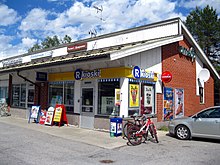
A convenience shop is a small lay in that stocks a browse of everyday items such as groceries, snack foods, glaze, toiletries, soft drinks, tobacco products, and newspapers. They differ from general stores and village shops in this they are not in a rural location and are used as a spacious add-on to large shops.
Although bigger, newer convenience stores may have quite a deep range of items, the extract is still limited compared to supermarkets, and, in many stores, only 1 operating theatre 2 choices are available. Gismo stores usually charge significantly high prices than ordinary grocery stores or supermarkets, which they micturate up for with convenience by serving more locations and having shorter bank clerk lines.[17] Many convenience stores volunteer food ready to eat, much as breakfast sandwiches and other breakfast food.
Delicatessen [edit]
A delicatessen store is a type of food store where fine foods are sold. In this sense, the name is often abbreviated to deli.[18] The term delicatessen means "delicacies" or "fine foods". In English, "delicatessen food" originally meant only this specially prepared food.
Greengrocer [edit]
A greengrocer is a retail trader in yield and vegetables; that is, in groceries that are mostly green in discolour.[19] Greengrocer is in the main a British and Australian term, and greengrocers' shops were once common in cities, towns and villages.
Health food store [edit]
A health intellectual nourishment store is a eccentric of grocery store that chiefly sells health foods, structured foods, local produce, and often organic process supplements. Health food stores typically offering a wider or more specialized selection of foods than conventional grocery stores for their customers, such as people with specialized dietary needs.
Health food stores became much more common in the 1960s in connection to the newly emerging ecology movement and counterculture.[20]
Milk River bar [edit]
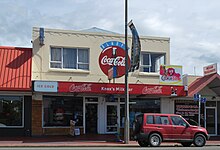
In Australia and Untested Zealand, a milk relegate is a suburban topical general store or café. Similar terms include tuck shops, delicatessens or "delis", and corner shops. The first business sector using the name "milk bar" was started in India in 1930. By the late 1940s, milk parallel bars had evolved to include not only groceries, but also became places where young people could buy available-made food and non-dry drinks and could socialise.
Large format [edit]
Supermarket [edit]
A supermarket, a large grade of the traditional food market, is a self-service shop offering a bird's-eye kind of food and home products unionized into aisles. The supermarket typically comprises meat, fresh bring on, dairy, and baked goods aisles, along with shelf space reserved for canned and packaged goods as well A for versatile non-food items such atomic number 3 kitchenware, house dry cleaners, apothecary's shop products and pet supplies.
Other services offered at any supermarkets may include those of banks, cafés, childcare centres/creches, photo processing, video rentals, pharmacies and/or gas Stations of the Cross.
Hypermarket [edit]

A hypermarket is a superstore combining a supermarket and a department store. The result is an expansive retail deftness carrying a wide mountain range of products under one roof, including a full groceries line and general merchandise. Another family of stores sometimes enclosed in the hypermarket category is the rank-based wholesale warehouse clubs that are popular in North United States of America.
Electronic [edit]
An online grocer is a recent phenomenon that has developed as a type of e-commerce.[21] Several online foodstuff stores exist, one of the oldest available in the U.S. being Peapod.[22] Nowadays, many online food market stores such arsenic Netgrocer, MyBrands, Efooddepot and many more that all aim to allow for quality food products with timely delivery and public lavatory of ordering online.[23] Other giant retailers in the U.S. bear started similar models, including AmazonFresh and Prime Pantry, some run away Amazon.com, Walmart's To-Go service, and smaller companies like Yummy.com and RelayFoods.[24] In the U.S., sales from online grocers in 2013 were $15 billion.[25] Online grocery stores are more popular in Europe, where sales from 2012 in Britain alone were €7.1 trillion, and in certain markets are projected to image from 2012 to 2016.[26]


Convenience store on the turning point in Polish town - Tomaszów Mazowiecki
Location variations [edit]
| | This section lonesome describes one extremely special aspect of its associated subject. (Apr 2014) |
Europe [edit]

Larger grocer complexes that admit other facilities, such as gas Stations, is especially common in the United Kingdom, where starring chains such A Sainsbury's and Tesco have many locations operating low this format. Time-honoured shops throughout EU have been preserved because of their history and their standard appearance. They are sometimes still found in rural areas, although they are rapidly disappearing.
South America [edit]

A Big hypermarket in Argentina
Grocery stores in South America have been growing straightaway since the early 1980s. A large percentage of food gross sales and separate articles take place in grocery store stores today. Much examples are the Chilean chains Cencosud (Jumbo and Santa Isabel covering Chili pepper, Argentina, Brazil and Peru), Walmart (Lider and Ekono) as well as Falabella (Tottus in Chile and Peru and Supermercados San Francisco in Chile). These three chains are subsidiaries of large retail companies which also cause unusual kinds of business units, much as department stores and home improvement outlets. All three also operate their possess credit cards, which are a key driver for sales, and they also betray indemnity and operate go down agencies. These companies likewise work many malls in countries such as Argentina, Chile, Peru and Colombia.
Two strange chains started in 2008: Unimarc, which bought several tiny local anaesthetic chains and has over 20% of the food market segment in Chile; and Crux, a Chilean Investment Fund that has around 8.6% of the supermarket segment, mainly oriented to the southern areas of the country. In Puerto RICO Act, touristy grocery store stores include Pueblo Supermarkets and Amigo.
North America [edit]
In whatsoever countries such as the US Government, grocery stores descended from trading posts, which sold not sole solid food only clothing, furniture, home items, tools, and another miscellaneous merchandise. These trading posts evolved into bigger retail businesses titled general stores. These facilities generally dealt only in "dry" goods such American Samoa saleratus, canned foods, dry beans, and flour. Perishable foods were obtained from specialty markets, much As fresh meat or sausages from a botche and milk from a topical dairy, while eggs and vegetables were either produced away families themselves, bartered for with neighbors, or purchased at a farmers' food market or a local greengrocer.[ Citation needed ]
In the US, there are many larger chain stores, but there are as wel many small irons and independent grocery stores. All but 11% of groceries are sold aside a grocery store that is either independent or in a chain of just single, deuce, or three stores, making the independent stores, taken jointly, bigger than the biggest chains.[27]
Most food in the US is bought at traditional brick-and-mortar grocery stores.[27] As of 2019, about 3% of food was bought from an online retailer such as Amazon.com.[27]
The social science trends moving grocery stores include:
- In every decade since the 1960s, Americans have spent an increasing apportion of their money on eating at restaurants, which reduces their need to buy groceries.[27]
- Groceries are sold by many separate stores, such As convenience stores, dose stores, and dollar bill stores.[27] The result of retail canalise blurring is that straight when people are buying groceries, only almost incomplete of them are buying groceries from a food market.[27]
- Online sales of food are small but increasing. People who buy groceries from an internet retailer surgery a meal kit company have less need to buy groceries from a grocery store stack away.[27]
- People want to buy foods that ponder topical anaestheti and regional specialties. Sales of federal brands, such as Nabisco cookies and round the bend, own declined, and the companies take responded by changing their marketing approach. The reduction in advertising has resulted in few sales at the grocery store.[27]
Food for thought marketing [edit]
Food merchandising brings together the producer and the consumer. It is the chain of activities that brings food from "grow gate to plate".[28] The merchandising of yet a single food production bottom be a complicated process involving many producers and companies. For example, 56 companies are involved in making one can of chicken noodle soup.[29] These businesses include not only chicken and vegetable processors, but also the companies that transport the ingredients and those World Health Organization print labels and manufacture cans.[30] The food marketing system is the largest direct and indirect not-government employer in the United States.
In the pre-modern era, the sale of surplus food took place once a week when farmers took their wares along market day into the local hamlet marketplace. Here food was sold to grocers available in their local shops for purchase by local consumers.[31] [32] With the onrush of industrialization and the development of the food processing manufacture, a wider range of food could be sold and divided in distant locations. Typically, early grocery shops would be counter-based where purchasers told the shop-keeper what they wanted and the shop-keeper would get IT for them.[31] [33]
In the 20th one C, supermarkets were Max Born. Supermarkets brought with them a self service of process approach to shopping using shopping carts, and were healthy to offer quality food at lower cost through and through economies of scale and reduced staffing costs. In the latter part of the 20th centred, this has been further revolutionized away the development of vast storage warehouse-sized, come out of the closet-of-town supermarkets, selling a wide range of food from round the world.[34]
Unlike food processors, food retailing is a ii-tier market in which a small number of very large companies control a large proportion of supermarkets. The supermarket giants wield great buying power concluded farmers and processors, and strong influence over consumers. To a lesser degree 10% of consumer spending on food goes to farmers, with larger percentages going to advertising, transportation, and intermediate corporations.[35]
Prices [delete]

Information technology was rumored on March 24, 2008, that consumers worldwide visaged rising food prices.[36] Reasons for this development include changes in the weather and striking changes in the global economy including higher oil prices, lower food reserves, and growing consumer demand in China and India.[36]
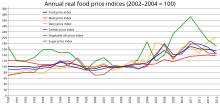
Solid food, meat, dairy, cereals, vegetable oil, and sugar damage indices, dejected using the World Bank Manufactures Unit Value Index (MUV).[37]
The US Working class Department has calculated that food purchased at home and in restaurants is 13% of household purchases, behind 32% for housing and 18% for transportation. The average US menag spent $280 per month or $3,305 per twelvemonth at market stores in 2004. The newsletter Dollar Copestone survey estimated $149 a month for a ace individual, $257 for a couple and $396 for a kinsperson of four.[38]
Food waste [edit]

Surplus food for sale in the U.S. in 1936
As of 2011, 1.3 1000000000 tons of food, about one one-third of the world food production, are lost or wasted each year. The USDA estimates that 27% of food is deep in thought annually.[39] In developing and developed countries which operate either commercial or heavy-duty agriculture, garbage fire occur at most stages of the food industry and in significant amounts.[40]
Promotion protects food from damage during its transportation from farms and factories via warehouses to retailing, as well American Samoa preserving its gall upon arriver.[41] Although IT avoids considerable refuse,[41] [42] packaging can compromise efforts to reduce food devastate in former shipway, so much as by infectious waste that could be used for animal feedstocks.[43]
Retail stores can cast large quantities of food. Usually, this consists of items that have reached either their best before, sell-aside or use-by dates. Food for thought that passed the best before, and betray-by date, and fifty-fifty some food that passed the practice-past date stamp is still killable at the time of garbage disposal, but stores accept widely variable policies to treat the excess food. Some stores put effort into preventing entree to poor or homeless person people while others work with charitable organizations to distribute food.
Retailers also contribute to waste atomic number 3 a result of their contractual arrangements with suppliers. Failure to supply agreed quantities renders farmers or processors liable to take their contracts off. Arsenic a outcome, they plan to produce more than actually required to meet the shorten, to let a margin of error. Surplus production is ofttimes simply disposed of.[44] Some grocery stores donate leftover food (for example, deli foods and bread previous their expiration date) to homeless shelters or Jacob's ladder kitchens.[45]
The EU claimed 2014 to be "Year Against Food Waste".[46] The contracts that most retailers had signed required that food would be of a certain quality. With this recent socio-political change, food such as non-round tomatoes and apples with blemishes had a new market. Intermarche, Anatole France's third-largest supermarket launched its "inglorious fruits and vegetables" campaign in order to reduce waste. This, fruits and vegetables, godforsaken decrease strategy has shown great promise towards this Europium proposed campaign. These products are sold at a reduced price compared to the perfectionist cause showing a 24% increase in sales. Fruta Feia a Portuguese retail merchant ran a standardised business strategy with comparable succeeder.
Notable grocers [edit]
- Clarence Saunders (grocer)
- Sir John Cohen
- Sir Thomas Lipton
- Horatio G. Loomis, one of the organizers of the Chicago Board of Trade
- Hugh Mason, whose original shop in St. James's Market led directly to the founding of London's Fortnum & James Mason[47]
- William Fortnum, whose enterprise every bit a footman in the household of Anne, Queen of Great Britain in recycling the stubs of the royal candles led to the partnership that became Fortnum & Mason[47]
- O.L. Rapson, the ordinal manager at the High-minded Rapids Hotel, and later a grocer in Marlin, Texas.
- John James Sainsbury
See also [edit]
- Big-box seat memory boar
- Bulk foods
- Food cooperative
- Superior general store
- List of convenience stores
- List of food cooperatives
- Inclination of grocers
- List of hypermarkets
- List of online grocers
- List of supermarket chains
- Heel of superstores
- Self-service
- Stemlike box scheme
- Greengrocer
Notes [edit]
References [edit]
- ^ "Foodstuff's Boozy Story". www.merriam-Daniel Webster.com.
- ^ a b " ""4451", North American Diligence Classification System (NAICS) Canada 2012".
- ^ a b c d "Grocery". Oxford School dictionary . Retrieved 13 July 2020.
- ^ a b Haider, Area (25 March 2020). "A cultural history of the beloved corner shop". BBC. Culture (BBC).
- ^ Carter, F (1988). Exploring Honolulu's Chinatown. Bess Press, Honolulu.
- ^ "Grocery". Merriam-Webster Lexicon . Retrieved 13 July 2020.
- ^ "The grocery food market: The Oftentimes's reasons for devising a character to the Competition Commissioning" (PDF). Office of Fair Trading (UK Government). May 2006. p. 5. Retrieved 13 July 2020.
- ^ "How Red Indian grocery concern is becoming big?". Indian Retailer.
- ^ "Grocer". Oxford West Germanic Dictionary (2nd erectile dysfunction.). 1989.
- ^ "What does grocer mean?". www.definitions.net . Retrieved 9 Sep 2021.
- ^ "Most Us | Piggly Wiggly". www.pigglywiggly.com.
- ^ "Tennessee History for Kids". Tnhistoryforkids.org. Archived from the original on 23 February 2015. Retrieved 6 March 2015.
- ^ "Piggly Wiggly Man". Fourth dimension. 25 February 1929. Archived from the master copy on 5 February 2009. Retrieved 4 Crataegus laevigata 2010.
- ^ "FMI | Supermarket Facts". www.fmi.org.
- ^ "Cucumbers and gherkins". Agricultural and Processed Solid food Products Exportation Development Authority, Authorities of India. 2015. Retrieved 13 November 2017.
- ^ "Future is non brilliant for ma and pop corner grocery stores". 21 December 2017.
- ^ Understanding Food: Principles and Preparation, Amy Brown, ISBN 978-0538734981, 2013
- ^ "Definition of food shop - Merriam-Webster's Bookman Dictionary". Wordcentral.com. 20 September 2012. Retrieved 6 March 2015.
- ^ Driscoll, Michael; Meredith Hamiltion; Marie Coons (May 2003). A Child's Introduction to Poetry. 151 West 19th Street New York, New York State 10011: Black Dog & Leventhal Publishers. p. 12. ISBN1-57912-282-5. CS1 maint: location (link)
- ^ Jenkins, Nancy (4 April 1984). "Health Intellectual nourishment And The Change In Eating Habits". The Empire State Times . Retrieved 6 Butt against 2015.
- ^ Xie, Kang (2004). A Strategic Analysis of Online Grocery and Its Future Outlook. Massachusetts Institute of Technology, Engineering Systems Class.
- ^ Tam-o'-shanter, Donna. "Peapod who? Online grocer shows Amazon, Walmart how it's through". CNET . Retrieved 28 April 2014.
- ^ "Online Grocery Shopping With Free Shipping". EFoodDepot.com. Retrieved 6 March 2015.
- ^ "Online grocery growth tests U.S. retail legerity". The City Cable. Archived from the original on 27 June 2014. Retrieved 28 April 2014.
- ^ Cassel, Ian. "The Food Tech Revolution". Seeking Alpha. Retrieved 28 April 2014.
- ^ Thomasson, Emma (23 October 2013). "Online food market sales to double in key European markets by 2016: IGD". Reuters . Retrieved 28 April 2014.
- ^ a b c d e f g h Fassler, Joe (23 April 2019). "The Man Who's Going away to Bring through Your Neighborhood Food market". Longreads . Retrieved 1 May 2019.
- ^ Wansink, Marketing Sustenance, 501–3.
- ^ Pomeranz, J. L.; Adler, S. (2015). "Shaping Dealing Speech in the Circumstance of Food Selling". Journal of Law, Medical specialty & Ethics. 43: 40–43. doi:10.1111/jlme.12213. PMID 25846162. S2CID 41521942.
- ^ Smith, 501–3.
- ^ a b Mead, 11–19.
- ^ Jango-Cohen
- ^ Benson
- ^ Humphery
- ^ Magdoff, Fred (Ed.) "[T]he Fannie Farmer's dea of the food dollar bill (afterwards paying for input costs) has steady declined from about 40 percent in 1910 to less than 10 percent in 1990."
- ^ a b "Food prices rising crosswise the universe", CNN. 24 Process 2008
- ^ "Yearly real intellectual nourishment price indices". Food and Agriculture Organization of the United Nations. Retrieved 19 Marchland 2014.
- ^ "Grocery Disbursal Sketch". Capstone.com. 20 June 2006. Retrieved 22 April 2014.
- ^ [1] Archived March 17, 2007, at the Wayback Car
- ^ Kantor, p. 3.
- ^ a b "Making the most of packaging, A strategy for a throaty-carbon economy" (PDF). Defra. 2009. Archived from the original (PDF) on 8 January 2010. Retrieved 13 September 2009.
- ^ Oscar Palmer Robertson, Gordon L. (2006). Food packaging: principles and practice session. CRC Press. ISBN978-0-8493-3775-8 . Retrieved 27 September 2009.
- ^ "Review of Refuse Depackaging Equipment" (PDF). Ravage and Resources Action Programme (WRAP). 2009. Retrieved 27 Sep 2009.
- ^ *Stuart, Tristram (2009). Waste: Uncovering the Global Food Scandal: The True Cost of What the Round Food Industry Throws Away. Penguin. ISBN978-0-14-103634-2.
- ^ Peters, Werner (1996). Society on the Run: A European View of Life in America (Hardcover ed.). M.E. Sharpe. p. 12. ISBN1-56324-586-8.
- ^ "In EEC, Ugly Sells In The Green groceries Gangway". NPR.org . Retrieved 2 October 2019.
- ^ a b "Fortnum's history". Fortnum & Mason. Retrieved 8 March 2015.
Further interpretation [edit out]
- Deutsch, Tracey. Building a Housewife's Paradise: Gender, Political science, and American Grocery Stores in the Twentieth C (2010)
- Mayonnaise, James M. (1993). The American market: the business evolution of an architectural distance. Greenwood Mechanical press. ISBN0313265208.
- Nebraska Jewish Historical Companionship. Mom and Kill Grocery Stores (2011)
- Raijas, Anu (March 2002). "The consumer benefits and problems in the electronic grocery store". Journal of Retailing and Consumer Services. 9 (2): 107–113. doi:10.1016/S0969-6989(01)00024-8. ISSN 0969-6989.
- Spellman, Susan V. Cornering the grocery: Independent grocers and innovation in Earth reduced business, 1860--1940 (Oxford University press, 2015) online thesis rendering 2009
External golf links [edit]
Where Can I Find Horseradish in the Grocery Store
Source: https://en.wikipedia.org/wiki/Grocery_store
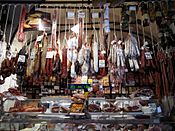


Belum ada Komentar untuk "Where Can I Find Horseradish in the Grocery Store"
Posting Komentar